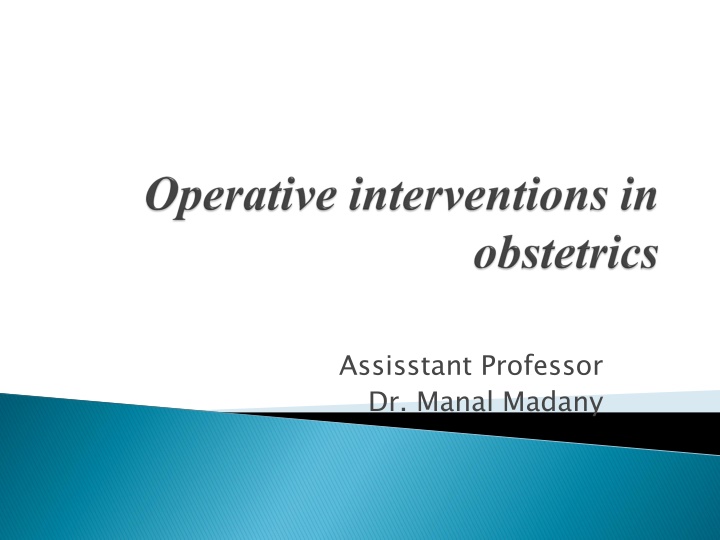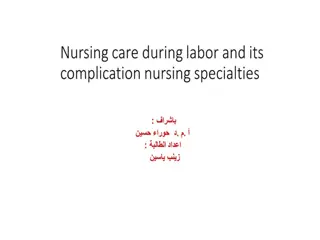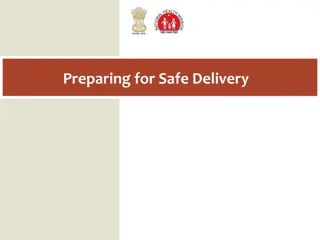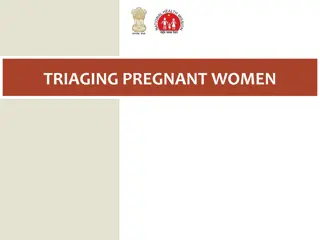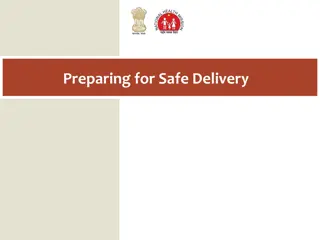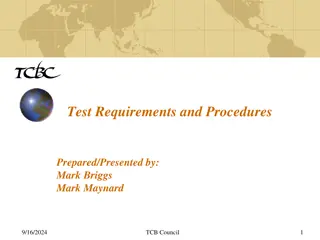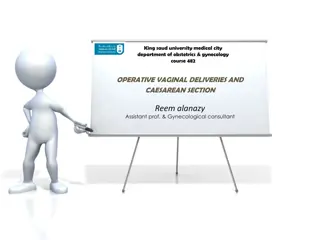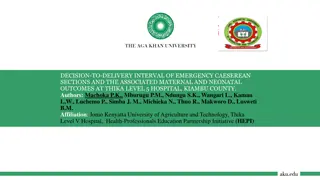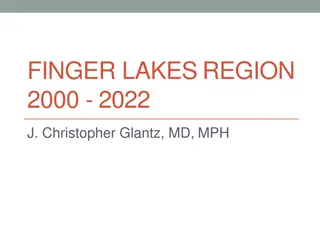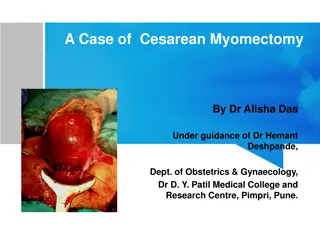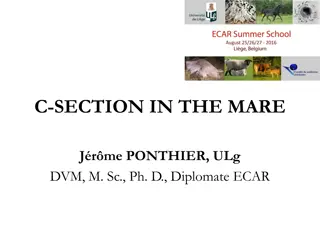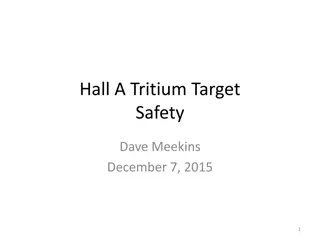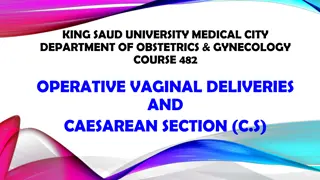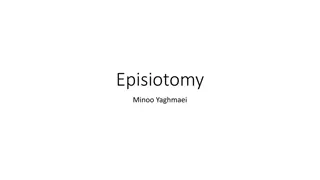Episiotomy and Caesarean Section Procedures
Episiotomy is a surgical incision of the perineum performed during labor to aid vaginal birth, while caesarean section involves incisions in the abdomen and uterus to deliver babies. The decision between midline and mediolateral episiotomy, risks, repair procedures, and comparisons are discussed. Informed consent, anesthesia, and potential complications like hemorrhage, infection, and dyspareunia are also addressed. The prevalence, reasons, and considerations for each procedure are highlighted.
Download Presentation

Please find below an Image/Link to download the presentation.
The content on the website is provided AS IS for your information and personal use only. It may not be sold, licensed, or shared on other websites without obtaining consent from the author.If you encounter any issues during the download, it is possible that the publisher has removed the file from their server.
You are allowed to download the files provided on this website for personal or commercial use, subject to the condition that they are used lawfully. All files are the property of their respective owners.
The content on the website is provided AS IS for your information and personal use only. It may not be sold, licensed, or shared on other websites without obtaining consent from the author.
E N D
Presentation Transcript
Assisstant Professor Dr. Manal Madany
Is a surgical incision of the perineum performed during the second stage of labour to enlarge the vulval outlet and assist vaginal birth. - It affect up to 90% of primigravida. -It s a second degree perineal tear. Types: a- Midian (midline) b- Mediolateral
The question of informed consent needs to be addressed during antenatal care; when the fetal head is crowning, it is not possible to obtain true informed consent. An episiotomy is performed in the second stage, usually when the perineum is being stretched. If there is not a good epidural, the perineum should be infiltrated with local anesthetic drug. The incision can be midline or at an angle from the posterior end of the vulva (a Medio lateral episiotomy).
A Mediolateral episiotomy should start at the posterior part of the fourchette, move backwards and then turn medially well before the border of the anal sphincter, so that any extension will miss the sphincter . A sharp scissors is used to make a single incision about 3 6 cm depending on the size of the perineum. The depth involves the superficial perineal muscles like a second degree tear. The episiotomy must be made in a single cut. If it is enlarged by several small cuts , a zigzag incision will be produced which will be difficult to repair.
Hemorrhage Infection Extension to the anal sphincter (third/fourth- degree tears). Dyspareunia
Comparison between midline (median) and mediolateral episiotomy: Median Mediolateral 1-Muscle is not cut 1- Muscle is cut 2-Blood loss is less 3-Repair is easy 3- Repair is difficult 4-Dyspareunia is rare 4- Dyspareunia is more 5-Extension if occurs may 5- Relative safety from involve the rectum 2- Blood loss is more rectal involvement
Is a surgical procedure in which incisions are made through a woman s abdomen (laparotomy) and uterus (hysterotomy) to deliver one or more babies. In the UK, between 25% and 30% of all babies are now delivered by caesarean section.
1-Small pelvis 2-Dystocia 3-Cord prolapse 4-Maternal medical disease like hypertension,DM 5-Placental problems like placenta previa ,abruption placenta 6--Abnormal presentation,breech ,transverse lie 7-Macrosomia 8- Multiple gestation 9- Sexually transmitted infections such as genital herpes
Up to70 per cent of women with a previous Caesarean section can achieve a vaginal delivery. Providing the first operation was carried out for non-recurrent cause, and providing the obstetric situation close to term in the succeeding pregnancy is favorable, then it is appropriate to offer a trial of labour to any woman with a previous uncomplicated lower uterine segment. Patient choice cannot and should not be ignored in decisions regarding management, and it is important to discuss the risks and benefits of elective Caesarean section as compared to trial of vaginal delivery.
Elective Caesarean section avoids labour with its risk of perineal trauma(urinary and fetal problems), the need to undergo emergency Caesarean section, and scar dehiscence/rupture with subsequent morbidity and mortality. However, elective Caesarean section carries maternal risks: increased bleeding, thromboembolism, febrile morbidity, prolonged recovery, long-term bladder and increased risks of placenta praevia
Informed consent must always be obtained prior to operation. The bladder should be emptied before the procedure. A left lateral tilt minimizes compression of the maternal inferior vena cava and reduces the incidence of hypotension (with its consequent reductions in placental perfusion).
1-The Pfannenstiel incisionThe skin and subcutaneous tissues are incised usinga transverse curvilinear incision two finger breadths above the symphysis pubis extending from and to points lateral to the lateral margins of the abdominal rectus muscles. 2- The infra-umbilical incisionA vertical skin incision is indicated in cases of extreme maternal obesity, suspicion of other intra-abdominal pathology necessitating surgical intervention, or where access to the uterine fundus may be required (classical Caesarean section). The lower midline incision is made from the lower border of the umbilicus to the symphysis pubis.
Pfannenstiel incision has a better cosmetic appearance, better healing and less incidence of incisional hernia but it is more time consuming associated with more blood loss and gives less exposure.
1- A lower uterine segment incision is used in over 95per cent of Caesarean deliveries due to ease of repair, reduced blood loss and low incidence of dehiscence or rupture in subsequent pregnancies
2-There are relatively few absolute indications for classical section (which incorporates the upper uterine segment. These include: a lower uterine segment containing fibroids a lower segment covered with dense adhesions, both of which may make entry difficult. placenta praevia, transverse lie with the back down, fetal abnormality (e.g. conjoined twins). Caesarean section in the presence of a carcinoma of the cervix (so as to avoid damage to the cervix and its vascular and lymphatic supply).
1-increased blood loss 2- risk of uterine rupture prior to or during labor in a subsequent pregnancy.
A-Intraoperative complications: 1- Bowel damage 2- Caesarean hysterectomy The most common indication for Caesarean hysterectomy is uncontrollable maternal haemorrhage ;The most important risk factor for emergency postpartum hysterectomy is a previous Caesarean section especially when the placenta overlies the old scar, increasing the risks of placentae accrete 3- Haemorrhage may be a consequence of damage to the uterine vessels, or may be incidental as a consequence of uterine atony or placenta praevia 4- Placenta praevia .The proportion of patients with a placenta praevia increases almost linearly after each previous Caesarean section 5- Urinary tract damage .The risk of bladder injury is increased after prolonged labor where the bladder is displaced caudally, after previous Caesarean section where scarring obliterates the vesico-uterine space
B-Post-operative complications: 1-Infection and endometritis :Women undergoing Caesarean section have a 5-20 fold greater risk of an infectious complication when compared with a vaginal delivery. 2-Pulmonary emboli and deep vein thrombosis Deaths from pulmonary embolism remain the leading direct cause of maternal death, and Caesarean section is a major risk factor 3-Psychological all difficult deliveries carry increased maternal psychological and physical morbidity.
